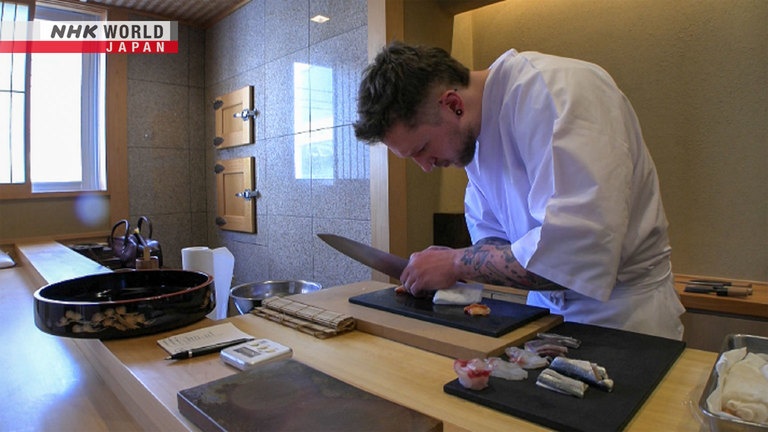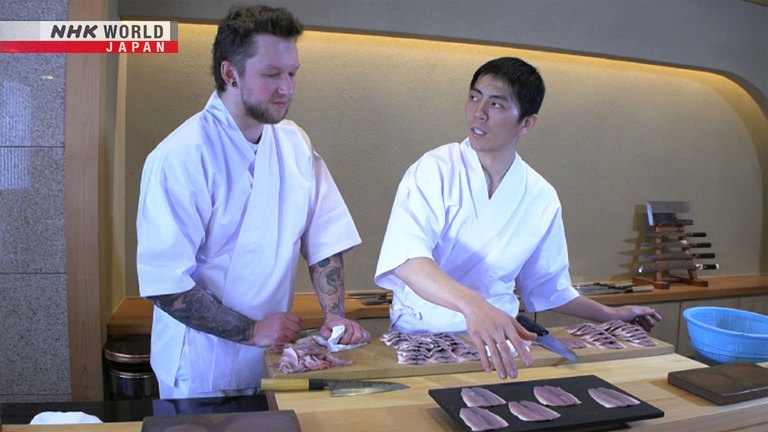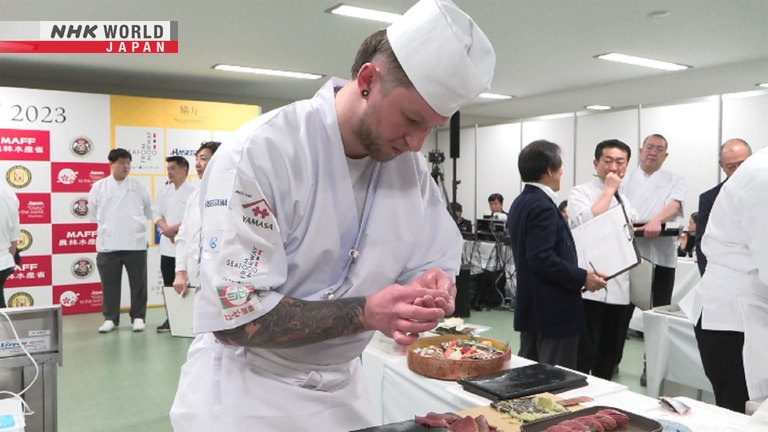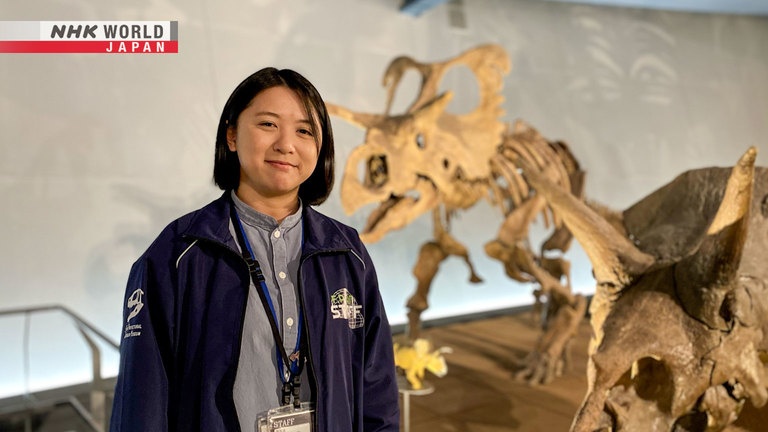Top Your Sushi With Conviction
We meet Jan Markiewicz from Poland, who trains at a Tokyo sushi restaurant in preparation for the World Sushi Cup, as well as Taiwanese Su Ling, a curator at the Fukui Prefectural Dinosaur Museum.




Transcript
Where We Call Home.
Pursuing the art of preparing sushi in Japan is this young man.
Jan Markiewicz, from Poland.
With the ambition of becoming "the best in the world," he trains at a leading restaurant in Tokyo.
"I like 'Edomae,' so I really want to be the top there."
His mentor is a master sushi chef who values both tradition and innovation.
With passion and devotion, he coaches Jan for the upcoming "World Sushi Cup."
He teaches Jan to always strive to surpass himself, not only for the competition.
"I just care about the rest of your life."
How will Jan fare in the World Cup?
Let's follow this budding chef's journey along the road to sushi mastery.
Ebisu in Tokyo.
At the top floor of this building is a sushi restaurant well known among gourmets from around the world.
It opened in 2019.
The simple interior only accommodates a total of eight counter seats.
A course meal featuring a selection from the chef costs about 270 US dollars per person.
Each piece is a reflection of his respect for traditional methods.
Toppings require time and effort to prepare.
Using an old-fashioned ice box keeps the fish fresh and lets it finely age while preventing it from drying.
The restaurant is so popular it's always fully-booked about three months in advance.
"We've been trying so many other places. This is pretty good!"
"Thank you."
"Yeah. Every piece is amazing."
"Thank you so much for that compliment."
In the kitchen are young staff members aspiring to become master "shokunin," the Japanese word for "artisan."
Jan came to Japan from Poland last fall.
He's in charge of preparing fish for toppings, raw or grilled.
Here, he cooks blackthroat seaperch on charcoal to rid it of excess moisture and seal in its flavor.
Seaperch, coming right up!
Jan, who's only been working here for five months, still relies on the chef's supervision and advice.
"I am not confident to do it myself."
"But usually, he comes and he checks everything."
Jan's father, who runs his own business, had hoped his eldest son would pursue higher education.
However, unable to forget the taste of sushi he once ate as a child,
Jan decided to become a "shokunin," in spite of his parents' opposition.
He trained for five years at different sushi restaurants throughout Europe.
"Sushi is so simple. There aren't that many ingredients."
"So, definitely, they need to be high quality, and also the technique must be on the point."
"So, I think it's really beautiful, like, simplicity."
"So, that's why I love sushi, I think."
It was through social media that Jan came to know chef Endo Norihito - the man who would become his mentor.
When Jan asked to become his apprentice, Endo gladly took him under his wing.
Now, he also entrusts Jan with attending customers.
This is so he can learn to keep a constant eye over the entire restaurant in order to serve diners with perfect timing.
Welcome!
Two towels!
But the towels have yet to arrive.
Towels!
Get to it!
"Jan, Jan."
"Everybody... This, is secondly. What did I say?"
In a French restaurant, you can
just concentrate on cooking.
But with counter sushi,
you need to do two things at once.
You're just taking care of one thing.
That's not good.
Work is usually over after 11 p.m.
Jan lives a five-minute walk from the restaurant, at an apartment set up by Endo.
He shares the place with a fellow apprentice, who joined the staff before him.
Andrew Guan from Canada is like a big brother to Jan.
"Kampai."
"Cheers to we both know two words!"
"What do I think about Jan?"
"Very honest guy."
"Honest."
"Very generous, always thinks about other people. It's good."
"No, for real, though."
His mentor is oftentimes strict and demanding, but thanks to that, Jan can feel he's been making progress.
"That's really nice that he always tries to, like, explain why we're doing something."
"You always need to have, like, some kind of, like, recipe for cooking or, like,
how long you do something for, and you need to have a reason for everything."
"And then, together, it's cooking."
"This is what Endo-san said, and that's actually, I think, a good philosophy."
Jan holds much admiration and respect for his teacher.
Endo once studied in England, pursuing his dream of a career playing soccer.
He knows very well the hardships of following one's dream abroad.
That's why he sees much potential in Jan.
In spite of the huge language barrier...
he decided to come to train
in Japan for a year.
He has the determination to succeed.
Life is short, but cuisine
lasts for millenniums.
I contribute to a small part of it.
So, I want to pass on all of
my knowhow to my staff...
so that they can pass it on
to future generations.
A key determinant in sushi's flavor and quality is the preparation of the ingredients.
Endo wishes to fully transmit the knowhow and skills he gained over years of experience.
Endo insists on procuring fish on which a special method was employed to swiftly shut down their nervous system.
This ensures the fish stays fresh and flavorful longer.
Even mackerel, a fish that's quick to go stale.
"Jan."
"This is nice."
"Most people say you can't eat raw mackerel, but it's possible."
"I mean, yeah, if we don't die today, it means that it's possible."
Endo regularly takes his apprentices on field trips to visit farms and other producers.
Today, they traveled all the way to a sake brewery in Akita.
Their sake is served at the restaurant.
Endo wants his staff to keep in mind the diligent efforts producers like this brewer pour into their craft,
and to convey that in the sushi they prepare and serve.
They use new barrels when
they want to make sake rich in flavor.
So, they use new barrels
for more polished rice?
They use them for one year,
or up to two years?
Up to two years basically.
"One tank is different
than another tank."
"So, it's showing the handmade stuff.
It's the same with sushi, it's handmade."
"Handmade is quite beautiful."
Jan has been training to be a sushi "shokunin" for five years.
He's now taking on a new challenge: the world championships.
The World Sushi Cup has been held since 2013.
It's a contest of skill between chefs from around the globe.
Jan meets the five-year minimum experience requirement.
But he's having difficulty with a particularly crucial technique.
He has to prepare "kohada," a fish that isn't commonly used in Europe.
"For cutting, yeah, cutting is definitely harder."
"You really need to practice cutting."
"This 'kohada' is so small and so cheap."
"And, I think nobody farms 'kohada' because it's not worth it."
Luckily, Endo is here to teach him.
If you can do "kohada"...
you can prepare any fish.
Slicing small fish needs precision.
Preparing it really shows
a chef's ability with a knife.
After the "kohada" is cut up, salt is used to remove its fishy smell before it's marinated in vinegar.
Only then can it become a tasty topping.
Its preparation truly embodies the essence of sushi making.
"A little bit worse."
The flesh of the fish Jan prepared doesn't look smooth along the line where the bones were removed.
This will negatively affect the taste during marination.
"This is, you know, this is pretty much OK, but not 100% yet."
- "Not yet."
- "You know."
"It can be improved in some point, and this is just... the difference just between 99 and 98, just one point."
"But we have to improve this point..."
Jan continues to practice over and over again.
In another part of the competition, each chef must prepare sushi with a single ingredient for the judges to sample.
Jan decided to top his with something unconventional: pigeon.
Endo likes to explore new possibilities, and serves sushi topped with pigeon at the restaurant once a year.
And so, Jan chose it for the competition.
But something's wrong.
"You can't leave..."
"You can't cook like this."
"That's gonna stink."
"Look at me, look at me."
"Seriously, everybody can cut it..."
Jan was about to cook the meat without correctly removing the entrails or bones first.
He failed to properly prepare his topping.
"I don't care if you win or lose this competition."
"I just care about the rest of your life."
"And I can't let you go like this."
Endo does his best to impart to his apprentice the fundamental principles of sushi.
Faced with his own lack of experience, Jan realizes he still has a long way to go.
The World Sushi Cup is about to begin.
The venue is the Toyosu Fish Market.
Nineteen sushi "shokunin" from nine countries and territories are taking part.
In the topping preparation event, Jan did an amazing job, and successfully moved on to the finals.
"Start!"
The time limit is sixty minutes.
Participants now compete in two events: "creative sushi" and "tasting."
For the creative portion, many of the contestants put effort in very decorative assortments.
Jan chose to go with traditional-style sushi, commonly referred to as "edomae" for its simple and iconic beauty.
Next, here comes the single-topping tasting event.
As planned, Jan prepares sushi with pigeon.
Contrary to what he did in the "creative" category, this time he goes with something innovative.
- What's this?
- Pigeon.
- Pigeon?
- Yes.
What do the judges think?
It's good.
At last, the winners are announced.
And the world sushi champion is...
"Number eleven!"
The grand prize goes to a "shokunin" from Portugal.
This is his fourth participation in the World Cup.
Unfortunately, Jan didn't place among the top three.
What is it he's lacking?
It's a question to which Jan continues to look for an answer.
"I didn't win anything."
"Like, I didn't make something
that I'm not happy with."
"It's more, like, my style.
I'm just happy with the outcome."
"It makes us realize what we lack
and what we need to work on."
"And if you have something in your mind,
put it into action."
"We can challenge again."
Believe in yourself, follow your convictions, and keep making sushi.
Simple but encouraging words from his mentor.
A Zen Buddhism phrase says,
"Enlightenment isn't found in letters."
The essence can't be expressed in words.
Jan has to discover it
and feel it by himself.
"I feel, like, small things
that I still need to improve."
"If you just want to be OK,
you'll never be a true 'shokunin.'"
"Always go one step... step higher."
Jan continues to aim for new heights in his training as a sushi master.
Hi! I'm Su Ling.
I'm a curator at a dinosaur museum.
I'll show you my work.
Katsuyama, Fukui Pref.
This is one of Japan's major
dinosaur fossil excavation regions.
Fukui Prefectural Dinosaur Museum.
9:00 a.m.
opening time.
On exhibit are 50 whole specimens
of dinosaur skeletons.
Employing 16 researchers, the museum
is at the forefront of Japanese paleontology.
A popular activity is a workshop
called "Fossil Research Training."
Lots of activity reservations today?
Here, visitors feel like researchers,
and experience different steps...
in the research process.
Participants look for fossils
in stones from 120 million years ago.
Ling is in charge of supervising
the training activity.
Is this a scale?
Let's see.
It's true the section isn't very smooth.
- It's a scale.
- Alright!
He found a scale fossil.
Well done!
They break a stone, and try
to identify any fossil they find...
and sort them by themselves.
It's the first step in research.
I want children to know
how fun research can be.
What kind of fossil is it?
Does it look like a scale,
a shell, or a plant?
Curators pass on knowledge and materials
to future generations.
- This.
- Yes!
This is a large shell.
It's a little cracked.
- You found a shell fossil!
- I found a shell!
When children find one fossil
after another with their own hands...
and shout, "I found one!"
It makes my work feel so rewarding.
A fan of dinosaurs since childhood,
Ling joined fossil dig tours abroad.
Thinking such large animals
used to exist was inspiring.
That's how I came to love dinosaurs.
She came to Japan and pursued
graduate studies in paleontology.
Later, she found work
that was unrelated to research.
I realized I wasn't the type of person
to be absorbed in doing research.
I gave up on studying dinosaurs
and chose to work for a private company.
But her love for dinosaurs persisted.
In 2021 she started working at the museum.
This is the head of the educational
activities division...
Miyata-san.
When it comes to holding research
activities visitors will enjoy...
Ling is invaluable.
We researchers can be very particular
about our work.
Ling understands the world of research.
She can also see when our particularities
prevent activities from going smoothly.
Then she finds solutions
to work things out.
During events, we find points
that need improvement.
So, to provide even better experiences...
I'll keep doing my best.
2:00 p.m.
preparing the next event.
I'm in charge of a handcraft
workshop for kids.
I thought of a workshop where kids
print dinosaurs on a handkerchief...
using eraser rubber stamps.
I give them a more realistic touch.
The children can freely create
their own unique dinosaur worlds.
I hope it makes them want to learn...
and deepen their interest in the exhibits
we have at the museum.
My treasures...
are these dinosaur picture books.
It's where my love for dinosaurs began.
I hope the workshop and events
I create inspire people...
just like these books did for me.
If dinosaurs can encourage children...
to study things like natural science,
it'd be wonderful.